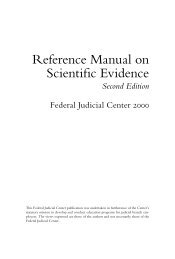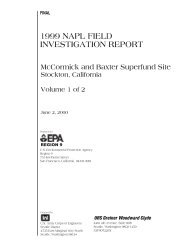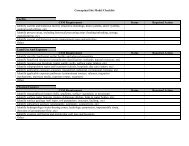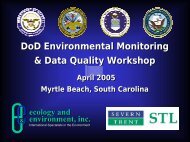Source Zone Delineation Demonstration Report - Triad Resource ...
Source Zone Delineation Demonstration Report - Triad Resource ...
Source Zone Delineation Demonstration Report - Triad Resource ...
Create successful ePaper yourself
Turn your PDF publications into a flip-book with our unique Google optimized e-Paper software.
6.1 Conventional Sampling and AnalysisTwo conventional methods of investigation that differ by the technique used to advance the boring andcollect soil samples were considered - HSA and DPT. A summary of the major tasks associated witheach of these methods of investigation and the estimated cost for each task is summarized in Table 6.1 forHSA and in Table 6.2 for DPT.For the conventional investigation, it is assumed that soil samples are collected and submitted to an offsitelaboratory for volatile organic compound (VOC) analysis. It also is assumed that two distinct phasesof field investigation are necessary during a conventional investigation. The second phase ofinvestigation is required to address data gaps remaining after the evaluation of the analytical datagenerated during the first phase of the investigation. Thus, it is assumed that two separate soil samplingevents and subsequent data evaluation periods are required for both hypothetical conventional methods ofinvestigation. Assumptions common to both the HSA and the DPT investigations include:Phase I Investigation The advancement of 17 borings each to 60 feet bgs for a total of 1,020 linear feet. The collection of 20 soil samples from each boring, starting at 20 feet bgs with a nominal spacing of 2feet. The collection of quality control (QC) samples at the rate of 10% of the primary samples, for a totalof 374 samples (340 primary samples and 34 QC samples). Two sample shipments per day for 9 days for a total of 18 shipments for next day delivery. Sample analyses at an off-site laboratory for VOCs according to USEPA SW846 Method 8260.Phase II Investigation The advancement of six borings each to 60 feet bgs for a total of 360 linear feet. The collection of twenty soil samples from each boring, starting at 20 feet bgs with a nominal spacingof 2 feet. The collection of quality control (QC) samples at the rate of 10% of the primary samples, for a totalof 132 samples (120 primary samples and 12 QC samples). Two sample shipments per day for 3 days for a total of 6 shipments for next day delivery. Sample analyses at an off-site laboratory for VOCs according to SW846 Method 8260.A nominal soil sample spacing of two feet in the vertical extent was assumed to more closely match thenominal sample spacing of one foot achieved during the wireline soil sampling demonstrationsummarized in this report. Although soil samples could be collected on one-foot intervals using eitherHSA or DPT to provide a direct comparison with the sample spacing of a wireline investigation, a samplefrequency of one foot is typically not used during conventional investigations due to the associatedanalytical costs. For instance, the total analytical cost estimated for both phases of the hypotheticalconventional investigation would increase from approximately $68,000 to $136,000 if the samplingfrequency was increased from one- to two-foot intervals.March 2003 6-2 OU 12 <strong>Demonstration</strong> <strong>Report</strong>Final










